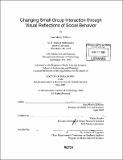| dc.contributor.advisor | Walter Bender. | en_US |
| dc.contributor.author | DiMicco, Joan Morris | en_US |
| dc.contributor.other | Massachusetts Institute of Technology. Dept. of Architecture. Program In Media Arts and Sciences | en_US |
| dc.date.accessioned | 2007-12-07T19:20:04Z | |
| dc.date.available | 2007-12-07T19:20:04Z | |
| dc.date.copyright | 2005 | en_US |
| dc.date.issued | 2005 | en_US |
| dc.identifier.uri | http://dspace.mit.edu/handle/1721.1/33007 | en_US |
| dc.identifier.uri | http://hdl.handle.net/1721.1/33007 | |
| dc.description | Thesis (Ph. D.)--Massachusetts Institute of Technology, School of Architecture and Planning, Program in Media Arts and Sciences, 2005. | en_US |
| dc.description | Leaf 141 blank. | en_US |
| dc.description | Includes bibliographical references (leaves 135-140). | en_US |
| dc.description.abstract | People collaborating in groups have potential to produce higher-quality output than individuals working alone, due to the pooling of resources, information, and skills. Yet social psychologists have determined that groups rarely harness this potential. This thesis proposes that technology in face-to-face settings can be used to address the social factors that have damaging influence on group decision-making processes. While there is much work in the area of collaborative software and groupware, this work differentiates itself with its specific aim to influence the way a group shares information without mediating the group's communication. By presenting visualizations to the group of individual levels of participation and turn-taking behavior, the technology aims to augment the group's communication ability, by making it more aware of imbalances. A series of dynamic displays positioned peripherally to a discussion were developed and used by a variety of groups during face-to-face meetings. Both observational and experimental results indicate that these displays influence individual participation levels and the process of information sharing used during a decision-making discussion. A display revealing real-time participation levels caused those at the highest levels of participation to decrease the amount they spoke. Viewing a visualization of previous turn-taking patterns caused those who spoke the least to increase the amount they spoke in a subsequent discussion; real-time feedback did not produce this change. Additionally, after reviewing their turn-taking patterns, groups altered their information-sharing strategies. | en_US |
| dc.description.abstract | (cont.) For groups that had poor sharing strategies on an initial task, this change improved their ability to share information related to the decision; for those who did not need intervention, feedback on turn-taking was not beneficial for their subsequent information sharing. The central finding of this research is that displays of social information, viewed during or after a meeting, bring about changes in a group's communication style, highlighting the potential for such displays to improve real-world decision-making. | en_US |
| dc.description.statementofresponsibility | by Joan Morris DiMicco. | en_US |
| dc.format.extent | 141 leaves | en_US |
| dc.language.iso | eng | en_US |
| dc.publisher | Massachusetts Institute of Technology | en_US |
| dc.rights | M.I.T. theses are protected by copyright. They may be viewed from this source for any purpose, but reproduction or distribution in any format is prohibited without written permission. See provided URL for inquiries about permission. | en_US |
| dc.rights.uri | http://dspace.mit.edu/handle/1721.1/33007 | en_US |
| dc.rights.uri | http://dspace.mit.edu/handle/1721.1/7582 | |
| dc.subject | Architecture. Program In Media Arts and Sciences | en_US |
| dc.title | Changing small group interaction through visual reflections of social behavior | en_US |
| dc.type | Thesis | en_US |
| dc.description.degree | Ph.D. | en_US |
| dc.contributor.department | Program in Media Arts and Sciences (Massachusetts Institute of Technology) | |
| dc.identifier.oclc | 61896606 | en_US |
